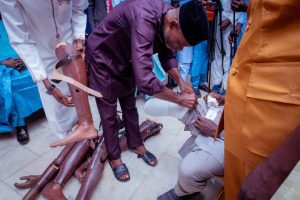The Kyrgyz startup ecosystem is still in its nascent stages and can’t boast an endless number of founders pursuing their dreams. But those focused on building hardware startups, which is generally significantly more challenging, are even a rarer breed. Despite all of that, there is an ambitious attempt to build artificial skin for prosthetics. Meet ArtSkin.
Not like a human hand
“Since childhood, I was mad about science and tech, and the first big thing that I made was a prototype of the first airplane by the Wright brothers. I dropped it from the second floor, and it was crushed after flying four meters. Later, when I was twelve, I saw a TV program about robot battles, and it was crazy! Since then, I have wanted to be able to make any kind of robots, and my dream has come true,” says Iliias Dzheentaev’s biography on LinkedIn. Dzheentaev is the CEO and Founder of ArtSkin.
ArtSkin is a hardware startup from Kyrgyzstan that develops artificial skin for prosthetic limbs. It was launched by Dzheentaev in 2024. Before that, he spent three years studying how human skin, the nervous system, and receptors work to understand how to design a device allowing proper touch sensations. The process was time-consuming and challenging due to the lack of relevant information.
“My initial prototype was a robotic arm manipulator. I encountered a challenge with grasping flexible objects – figuring out how to make the robot recognize when its claw had squeezed tightly enough to hold the object securely. To solve this, I developed a mechanism that overcomes the resistance of different materials, enabling the robot to firmly grasp objects of various shapes, textures, and densities. Although the mechanism was simple, it made me realize how important this problem is for robotics. This insight then led me to thinking about people who use prosthetics and whether they actually feel anything when wearing them”, Dzheentaev tells The Times of Central Asia.
He was not happy with the contemporary prosthetic solutions – basic body-powered mechanical prosthetics rely on physical motions, and more advanced bionic prosthetics translate electrical signals generated by muscle activity into movements, both of which lack feedback. And without the latter, control is incomplete, while with a human hand, one can easily understand its position as well as feel touch and pressure. With this in mind, Dzheentaev built his prototype with a single sensor to test the device on himself.
First steps
Things got serious when Dzheentaev visited the High Technology Park of the Kyrgyz Republic (HTP), where he was inspired by other founders pitching and raising funds for their startups. At the time, unfamiliar with this environment, Dzheentaev was using his salary to buy electronic components, order materials, and do designs.
Not long after, Dzheentaev took part in HTP’s two programs: Dive into Silicon Valley and Unicorn from KG. The finalists for the first one were selected in February 2024. Dive into Silicon Valley in an entry-level incubation program, which sends founders to spend two weeks in Silicon Valley during which they meet founders, venture capitalists, prospective customers, take part in hackathons and pitch sessions, and visit the headquarters of leading tech companies and top universities. Dhzeentaev had quality networking during this visit, meeting Stanford professors and fellow founders from the region, like Doszhan Zhussupov, CEO of the leading Kazakh AI-medtech startup, which creates AI solutions that are essential in emergency medicine.
Later the same year, Dzheentaev was admitted to a more advanced program, Unicorn from KG, which runs in partnership with Draper University’s Hero Training Program. The program is an intensive five-week pre-accelerator based in Silicon Valley. In April 2025, Dzheentaev won a $10,000 equity-free cash prize at the largest local tech conference, Central Asia Startup Cup.
Apart from taking part in various programs, Dzheentaev found himself a Co-Founder. Sultan Tukeshov, the President of the Association of Surgeons of the Kyrgyz Republic, with 20 years of experience in surgery, joined Dzheentaev on his journey to build ArtSkin. The partner was a good fit as he and his team were the first in the country to start fitting patients with bionic prostheses.
Global ambitions
In March 2025, Dzheentaev was admitted to Stanford’s Summer Session. Last month, ArtSkin was selected for the MIT DeepTech Program, a joint program of the High Technology Park and Kuo-Sharper Center for Prosperity and Entrepreneurship at Massachusetts Institute of Technology. Last week, ArtSkin was named fourth out of 400 startups in the Road to Battlefield Regional Final regional pitching round of the TechCrunch Disrupt 2025 selection by Silkroad Innovation Hub. Now he will pitch in the global lineup during TechCrunch Disrupt 2025, where he plans to present the prototype – a unified solution that can be adapted to different types of prostheses and integrated with VR – to show how the same technology can be applied in different areas. TechCrunch Disrupt is one of the largest global tech conferences and is held annually in Silicon Valley.
Dzheentaev has also received a grant of $50,000 from the High Technology Park to build a technical laboratory for developing an advanced version, testing, and preparing for clinical trials. By January 2026, Dzheentaev plans to develop a flexible prototype, which will have 16 sensors and operate similarly to human skin, including object temperature transmission, with a target to obtain a patent in the summer of 2026. Dzheentaev also plans to take part in accelerators and raise investments to cover the operating expenses since the team is working on enthusiasm alone.
“The biggest goal for us is to give people with prosthetic limbs back their natural touch sensations, because through them we feel the world around us. We also plan to integrate with virtual reality technologies, where people can not only see digital objects, but also feel and interact with them. I see great potential in our project, and who knows where this journey will take us?” Dzheentaev told The Times of Central Asia.











-1.png)


